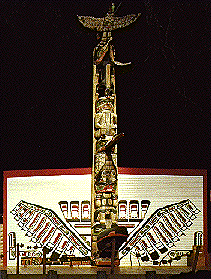Grand Hall tour
Central Coast House
On the Central Coast live the Kwakwaka'wakw, Heiltsuk, Owikeno and Haisla,
politically distinct groups of people who speak different, though related,
languages. Their territories,
adjacent to one another, stretch from northern Vancouver Island to a point
north of Kitimat.
 The façade of the clapboard house represents the house of Chief
Wakas, a nineteenth-century chief who was descended from both the Owikeno
and Nimpkisk peoples. The original house stood in Alert Bay from the
early 1890s until at least the 1930s.
The façade of the clapboard house represents the house of Chief
Wakas, a nineteenth-century chief who was descended from both the Owikeno
and Nimpkisk peoples. The original house stood in Alert Bay from the
early 1890s until at least the 1930s.
From his Owikeno ancestors, Wakas inherited a speaker's staff which
represented the chief's authority and was used by a person speaking on
behalf of a chief at a potlatch or other formal occasion. The carved
figures on the staff are emblems of the chief's family history. When
he commissioned the entrance pole for his house, Chief Wakas had the
carver re-create the figures on the speaker's staff. The figures evoke
the story of the acquisition by human beings of the dances, songs and
masks of the winter ceremonial.
You may enter the house.

 When the Wakas Pole was first
erected in front of the house in the 1890s, the archway through the
bottom figure served as the entrance to the house. Shortly afterward
a beak was added by Kwakwaka'wakw artist Dick Price. The top of the
beak was the prow of a canoe, with the lower part specially made
to complement it. Once the beak (large enough to admit a person)
was added, the pole became a ceremonial entrance to the house. For
everyday use a rectangular doorway was cut through the façade
beside the pole.
When the Wakas Pole was first
erected in front of the house in the 1890s, the archway through the
bottom figure served as the entrance to the house. Shortly afterward
a beak was added by Kwakwaka'wakw artist Dick Price. The top of the
beak was the prow of a canoe, with the lower part specially made
to complement it. Once the beak (large enough to admit a person)
was added, the pole became a ceremonial entrance to the house. For
everyday use a rectangular doorway was cut through the façade
beside the pole.
At the top of the pole is Thunderbird, Lord of the Upper World, and below is Killer Whale, Lord of the Undersea World. Below Killer Whale is Wolf, then comes Wise One, a human figure. Next is the mythical Cannibal Bird, and below him is Bear. At the base is Raven.
The façade was originally white with a dark border. In 1899 or
1900, the Raven figure at the base of the pole was completed with the
painting of tail feathers, wings and claws stretching across the
façade, and bringing the façade, the pole and the house
together into a single representation of the history of Wakas's family.


